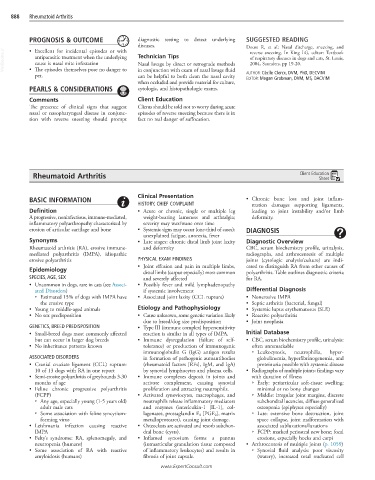Page 1765 - Cote clinical veterinary advisor dogs and cats 4th
P. 1765
888 Rheumatoid Arthritis
PROGNOSIS & OUTCOME diagnostic testing to detect underlying SUGGESTED READING
diseases. Doust R, et al: Nasal discharge, sneezing, and
VetBooks.ir antiparasitic treatment when the underlying Technician Tips of respiratory diseases in dogs and cats, St. Louis,
• Excellent for incidental episodes or with
reverse sneezing. In King LG, editor: Textbook
cause is nasal mite infestation
Nasal lavage by direct or retrograde methods
2004, Saunders, pp 19-20.
• The episodes themselves pose no danger to
pet. in conjunction with exam of nasal lavage fluid AUTHOR: Cécile Clercx, DVM, PhD, DECVIM
can be helpful to both clean the nasal cavity
EDITOR: Megan Grobman, DVM, MS, DACVIM
when occluded and provide material for culture,
PEARLS & CONSIDERATIONS cytologic, and histopathologic exams.
Comments Client Education
The presence of clinical signs that suggest Clients should be told not to worry during acute
nasal or nasopharyngeal disease in conjunc- episodes of reverse sneezing because there is in
tion with reverse sneezing should prompt fact no real danger of suffocation.
Rheumatoid Arthritis Client Education
Sheet
Clinical Presentation
BASIC INFORMATION • Chronic bone loss and joint inflam-
HISTORY, CHIEF COMPLAINT mation damages supporting ligaments,
Definition • Acute or chronic, single or multiple leg leading to joint instability and/or limb
A progressive, noninfectious, immune-mediated, weight-bearing lameness and arthralgia; deformity.
inflammatory polyarthropathy characterized by severity may wax/wane over time
erosion of articular cartilage and bone • Systemic signs may occur (one-third of cases): DIAGNOSIS
unexplained fatigue, anorexia, fever
Synonyms • Late stages: chronic distal limb joint laxity Diagnostic Overview
Rheumatoid arthritis (RA), erosive immune- and deformity CBC, serum biochemistry profile, urinalysis,
mediated polyarthritis (IMPA), idiopathic radiographs, and arthrocentesis of multiple
erosive polyarthritis PHYSICAL EXAM FINDINGS joints (cytologic analysis/culture) are indi-
• Joint effusion and pain in multiple limbs, cated to distinguish RA from other causes of
Epidemiology distal limbs (carpus especially) most common polyarthritis. Table outlines diagnostic criteria
SPECIES, AGE, SEX and severely affected for RA.
• Uncommon in dogs, rare in cats (see Associ- • Possibly fever and mild lymphadenopathy
ated Disorders) if systemic involvement Differential Diagnosis
○ Estimated 15% of dogs with IMPA have • Associated joint laxity (CCL rupture) • Nonerosive IMPA
the erosive type • Septic arthritis (bacterial, fungal)
• Young to middle-aged animals Etiology and Pathophysiology • Systemic lupus erythematosus (SLE)
• No sex predisposition • Cause unknown, some genetic variation likely • Reactive polyarthritis
due to breed/dog size predisposition • Joint neoplasia
GENETICS, BREED PREDISPOSITION • Type III (immune complex) hypersensitivity
• Small-breed dogs most commonly affected reaction is similar in all types of IMPA. Initial Database
but can occur in larger dog breeds • Immune dysregulation (failure of self- • CBC, serum biochemistry profile, urinalysis:
• No inheritance patterns known tolerance) or production of immunogenic often unremarkable
immunoglobulin G (IgG) antigen results ○ Leukocytosis, neutrophilia, hyper-
ASSOCIATED DISORDERS in formation of pathogenic autoantibodies globulinemia, hyperfibrinogenemia, and
• Cranial cruciate ligament (CCL) rupture: (rheumatoid factors [RFs], IgM, and IgA) proteinuria possible with systemic disease
10 of 13 dogs with RA in one report by synovial lymphocytes and plasma cells. • Radiographs of multiple joints: findings vary
• Semi-erosive polyarthritis of greyhounds 3-30 • Immune complexes deposit in joints and with duration of illness
months of age activate complement, causing synovial ○ Early: periarticular soft-tissue swelling;
• Feline chronic progressive polyarthritis proliferation and attracting neutrophils. minimal or no bony changes
(FCPP) • Activated synoviocytes, macrophages, and ○ Middle: irregular joint margins, discrete
○ Any age, especially young (1-5 years old) neutrophils release inflammatory mediators subchondral lucencies, diffuse generalized
adult male cats and enzymes (interleukin-1 [IL-1], col- osteopenia (epiphyses especially)
○ Some association with feline syncytium- lagenases, prostaglandin E 2 [PGE 2], matrix ○ Late: extensive bone destruction, joint
forming virus metalloproteases), causing joint damage. space collapse, joint malformation with
• Leishmania infection causing reactive • Osteoclasts are activated and resorb subchon- associated subluxations/luxations
IMPA dral bone (cysts). ○ FCPP: marked periosteal new bone; focal
• Felty’s syndrome: RA, splenomegaly, and • Inflamed synovium forms a pannus erosions, especially hocks and carpi
neutropenia (humans) (intraarticular granulation tissue composed • Arthrocentesis of multiple joints (p. 1059)
• Some association of RA with reactive of inflammatory leukocytes) and results in ○ Synovial fluid analysis: poor viscosity
amyloidosis (humans) fibrosis of joint capsule. (watery), increased total nucleated cell
www.ExpertConsult.com

